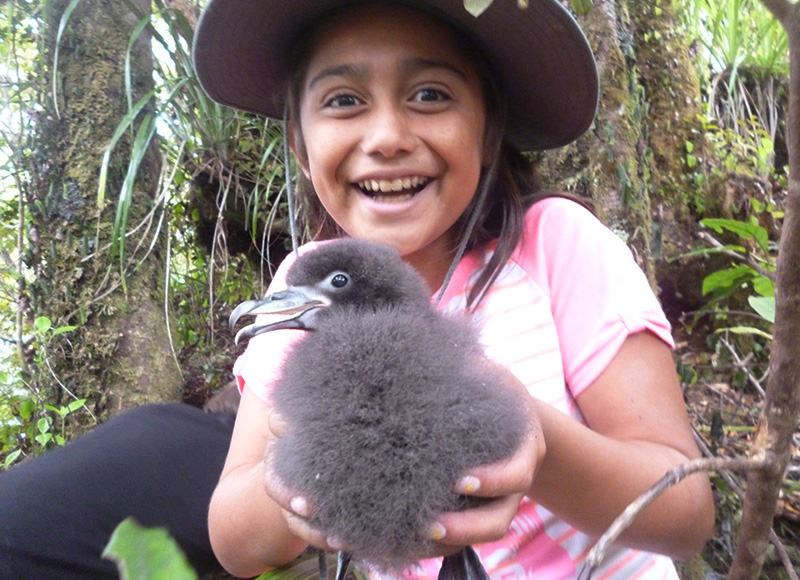Tāiko Across the Pacific
I cautiously peered into a gnarled puriri tree and stared eye to eye with a black petrel. I was elated – the birds were back, all the way from South America and preparing to breed, right here in my backyard.
‘My’ backyard is not mine at all, but is where my husband and I currently live with our seven year old daughter managing a 240 ha pest controlled native wildlife sanctuary in the north of Great Barrier Island in the Hauraki Gulf, New Zealand. Controlling pests is the essential component of the sanctuary work that enables the real interesting stuff to happen – creating a safe haven for our native species. Outside of keeping the rats, cats and rabbits at bay, our work involves the steady restoration of regenerating bush and pasture to habitat suitable to host a variety of threatened species.
One such species is the black petrel or Táiko, a migratory seabird that only breeds on Great and Little Barrier Islands in the Hauraki Gulf. There are only 1500 breeding pairs remaining and the species is in decline.
Black petrels used to be much more widespread – occurring across the North Island and even the upper South Island prior to the 1950’s, but habitat loss and predation have grossly restricted their range. They are ‘slow’ breeders producing just one egg per year from about five years of age. The parents share the incubation of the egg and care of the chick for almost six months throughout the kiwi summer and into the winter.
In this time the downy grey chick transforms from a fluffy dumpling to a sleek, muscular juvenile, ready to take on the Pacific migratory path. Like its parents the young bird is subject to accidental drowning as a result of being hooked on lines of both commercial and recreational fishing vessels.
Indeed, in New Zealand black petrels are identified as the most at risk seabird from fishing. At present this species’ prospects are bleak. Adults have to breed successfully 25 times during their life to sustain the current low population. With the oldest bird found to date 29 years old, a low reproductive rate and high juvenile fatality rate, this statistic is unlikely to be achieved. Without further protection to mitigate threats to this species, extinction is imminent in the next 30 years.
The potential for this to occur, in my daughters’ lifetime and our backyard, was unacceptable. I chose to take action. In association with Department of Conservation I prepared the Black Petrel Education Project to be delivered to schools on Great Barrier Island and further afield.
This bird is considered ‘our’ bird – it spends at least six months here over summer before departing for South America during winter, where ‘Petrel Negro’ is similarly viewed by coastal communities in Peru and Ecuador, and faces similar pressures from fishing. Before the education resource was even ready for roll-out in NZ I found myself fervently studying Spanish and planning to travel to the black petrels’ winter destination.
In my desire to spread the word and advocate for mitigation measures and protection of these iconic seabirds (many other seabirds experience similar threats) I had applied to the Winston Churchill Memorial Trust and was successful in receiving a travel grant to South America. In becoming a Churchill Fellow I could now plan for adapting and delivering the Black Petrel Education Project to schools in Peru, becoming an ambassador for these migratory seabirds and creating a link between host countries.
With the help of Forest and Bird, I established links with Pro Delphinus, a not-for-profit Peruvian conservation organisation committed to the conservation of threatened and endangered marine fauna, based in Lima. DOC again assisted with funding to help with delivery of the resource overseas. These resources have now been translated and a myriad of teaching props are being acquired in preparation for my departure in August.
The black petrels will beat me to my South American destination. I checked the burrows in the sanctuary just last week – only one persistent fledgling remained inside its dry, hollow-tree haven, perhaps unwilling to commit quite yet to the 11000 km journey across the Pacific. I can understand why – I have the pleasure of a jet aircraft to get me there and I’m very excited and just a bit apprehensive of the trip ahead, so I can only imagine how the petrel must feel.
The author wishes to express her thanks to Rebecca Gibson and the Department of Conservation for their support of the Black Petrel Education Project, the Winston Churchill Memorial Trust for the opportunity to travel to South America, and Karen Baird (Forest and Bird) and Joanna Alfaro (Pro Delphinus) for their support to make it all happen. The myriad of seabird advocates that provided feedback and support throughout this project exemplifies the passion and tenacity these individuals have to protect these and other threatened species in New Zealand and afar.

